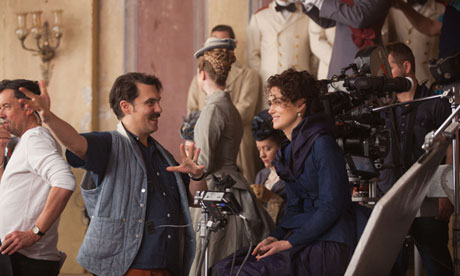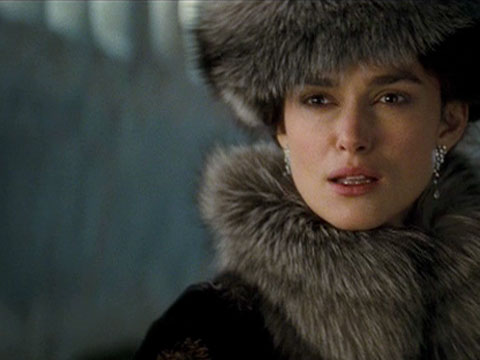Joe Wright looms out of the shadows of the vast set he's constructed for Anna Karenina. For some reason, as he beams through the darkness, I think of Orson Welles in The Third Man. It then it takes me a moment to realise that he has grown a moustache.
"Do you like what we've done with the place?" he laughs, gesturing around the dusty-looking, deserted theatre in which I seem to have found myself. Outside, this is Shepperton, but inside, I'm in 19th-century Russia, peering up at a wooden proscenium and peeking behind the wings, from where Joe has just sauntered.
For someone in the middle of a tricky and costly British film shoot, he seems remarkably relaxed. That moustache lends him the look of the carnival, but then he's always had something of the ringmaster about him when he works, the centre of his own universe of players and magicians.
The words of Wright's producer, Paul Webster, now ring in my ears. I've just come from his office, – in the David Lean building, no less – where he has filled me in on the background to this particular, peculiar production of Anna Karenina. "It's a Joe Wright-ified version that's for sure," explained Webster, who also produced the director's award-winning period dramas Pride and Prejudice and Atonement. "But the great thing about working with Joe is that he doesn't lie. You get bang for your buck because he knows he's got to share his vision with everyone and he's so aware of the team aspect of film-making.
"He believes if everyone's a part of it, they will give that bit more – that's very much the aspect of the theatrical showman about him. He loves to be MCing, front and centre. He does speeches and everything, and he's up before anyone else, at 4.30am, working out his shots, so by the time they all get on set at eight, he's been well into his day for hours. He's the most meticulously prepared person I've met."
With 83 speaking parts and 100 different sets, this is an enormous movie, requiring a steady hand and clear head in charge, particularly, as I'm about to discover, as no one really knows how it's all going to turn out.
Just 12 weeks ago, it wasn't going to be like this. Wright and his team were preparing to film Tom Stoppard's script of Tolstoy's novel in Russia. But wherever they went, scouting locations in St Petersburg, they kept hearing about previous films that had been shot there. The same applied to stately homes in England. "I was looking for angles, thinking if I shoot from high, it'll look like Russia," explains Wright. "But then the owners would say to me, 'Oh yes, we've had Keira Knightley here twice before', and I began to get this feeling of boredom and despair. I kept thinking there must be another way to make period drama interesting.
"On one despondent afternoon, I harked back to the halcyon days of my shoots on Pride… in the Bennet house, or in the mansion in the first part of Atonement. I remembered how much I loved having everyone around, in one place, with no time wasted journeying. And I just thought, idly, if I could shoot this new one in any one place, where would it be?"
The "big idea" he came up with is that it's almost all set in a theatre. One huge, unfolding stage, part doll's house, part ballroom. Characters swoosh from one set to another, smoothly transitioning mood and atmosphere. "I've always loved the films of Powell and Pressburger," Joe tells me. "They were able to have this heightened sense of dream, yet the drama was always very urgent and real. I always thought Charlie Kaufman's Synecdoche, New York was genius, too, even though I'm not sure I fully understood it. That doesn't matter – it was a poem. It's OK if something doesn't quite make logical sense. That's what films can do. They're fantasy."
Wright takes me on a quick tour. There are whole sets in separate rooms, waiting to be wheeled into position. I admit to being confused. I can't see it working. Wright seems impassioned, excited, frankly a bit mad. This could be a disaster, I think to myself, and half-wonder whether I should leave.
"The main theatre has been an ice rink, a horse race, a society ballroom, a train station, a cancan club," enthuses Wright. "Over here's the Vronsky house and through here is the hotel where Anna goes a bit doolally."
We dash through a door and up some scaffold steps to a set of plush, cobalt-blue rooms. Keira Knightley is deep in thought over a large Filofax-type binder book, her piles of hair tumbling over her white shoulders. Wright goes over to her and has a quiet word then peels off to stand behind a camera that his regular cinematographer, Seamus McGarvey, has been positioning, surrounded by his crew. I linger by a monitor to watch.
Knightley takes up her position on a crumpled bed, languorous and dangerous. Anna comes alive, dashing out of the sheets, through some double doors and into an adjoining room. It's one fluid take. "Bit of a wobbly finish," shouts Wright as the camera comes to rest. A chippie comes to batten down a floorboard, and they all go again.
It looks good to me. Sure enough, it's in the bag and we move on. Six months later, I see that very same shot on the film's first trailer.
I go for a wander, to try to get a feel for the ins and outs of this film. I visit Jacqueline Durran in her giant costume cupboard. The two-time Oscar nominee is surrounded by material and bulky, beaded costumes hang suspended high in the air like ghosts. Her obvious enthusiasm for working with Knightley is evident as she flicks me through the 1950s-couture-inspired sketches for Knightley's 1870s outfits. "Since she was young, Keira has always understood the importance of costume as part of character," she says. "This is rare in an actress, believe me. She's even got the gumption to turn the costume department's ideas down and comes up with sketches of her own.
"We've loved researching this together, but early on, Joe said he didn't want us constricted by the particular period. As the Russian aristocrats were obsessed with French culture in the 19th century, we just came up with the idea of tweaking it a bit and using the heyday of couture from the 1950s to emphasise Anna's modern streak. Some people will notice, others won't. But it really helped Keira understand Anna, just as 'that' green dress became a signature part of her in Atonement."
I march past sumptuous soldier jackets and elegant ballgowns, rows of them, like I'm in some frenzied sample sale. Outside, production designer Sarah Greenwood is waiting. This is her seventh collaboration with Wright and she takes me through her designs for this all-encompassing theatre set, based on the Kirov and the Mariinsky in St Petersburg – and a bit on north London's Alexandra Palace, actually.
Like Durran, Greenwood is an equal in the production, both of them integral to Wright's overall idea, both feeding into the whole with an effusive intelligence. She is preparing to go off to Russia, to the Unesco world heritage site of Kizhi island, where it is minus 30 degrees, to shoot some scenes with Domhnall Gleeson's character of Levin, whose protracted yet passionate love story with Kitty provides a thoughtful contrast to Anna's torrid emotional whirl. "He's the Tolstoy alter ego in the story, really," she says. "Joe sees him as the one true soul, so he gets to go off into reality, to leave the theatrical metaphor. He gets a proper house and fields and everything."
Downstairs, by the costume department, I bump into Aaron Johnson in shirt and breeches. He looks very relaxed. "Easy day for me," he grins. "Just got one scene, and I'm asleep for most of it." Five minutes later, someone interrupts our chat because his scene is now.
I follow him up to that inky set of rooms and take up my position in front of the monitor again. Wright and McGarvey have repositioned and the camera is ready to dolly in on Johnson as he's curled up like a depressed cat in an alcove. These are scenes from the later stages of Anna and Vronsky's affair, when exile has driven them to drugs and indolence. They are, literally, living in the wings of society.
As the camera moves in, Johnson stirs, like a startled beast. "Lovely," says Wright. "One more for luck." And they go again, quickly, smoothly but the first one's the keeper. That's two shots in the can already.
After I grab lunch with McGarvey on the top of an old double decker bus that stands for a canteen on the Shepperton lot, I knock on Wright's office deep in the studio maze. He's just tucking into a pie and salad and his assistant, Phoebe, brings us coffees. "Keira's looking good," I say. "She's proper grown-up now," smiles Wright. "She's developed incredibly as an actress and human being and she's really strong now. When we started working on Pride she was 19, a kid. And nothing really bad had happened to her. She'd never really had to ask the bigger questions – but over the past eight years, she's had to go deep and been challenged and been hurt and all of that makes you stronger. And she's still here. It would have been so easy to bugger off to Hollywood where they're all nice to her. But she dug her heels in and worked really, really hard."
Why does he enjoy working with her so much and so often? (In between films – and Wright has always managed to get the best performances out of Knightley – they've even done commercials for Chanel.) "I think she's exquisite, I really do," he says. "Lots of directors don't really talk to actors, they're too busy with cameras and stuff. But we did a lovely three weeks rehearsing. That's directing for me, that's what it's all about ultimately, and I'm sure it's what I took with me from having grown up in a puppet theatre."
Wright's parents founded the Little Angel Theatre in Islington, north London. His mother still runs it and it's where Wright learned everything. Looking at Anna Karenina, one can see the shifting scenery of his childhood puppet world merging with the big-budget movie world more than in any other of his works.
"You could certainly say that," he says. "At this point, I'm worried it might be all a bit camp. It could be the campest film made by a straight man, apart from Baz Luhrmann's films of course. But it is all about artifice and form and I just hope it works."
That visit to Shepperton has been on my mind a long time. It was a happy set and a big set, though I'm not convinced that back then anyone quite knew how it was all going to come together.
But I've seen it all finished now, and it works beautifully. The concept is elegant and exciting, a tragedy unfolding almost as a musical, the flow of images and intimate scenes matching the epic sweep of the novel, swapping literary conceits for theatrical ones, yet somehow remaining incredibly cinematic. Crucially, none of this sleight of hand gets in the way of the story.
In fact, the smooth scene changes – see, I won't even say cuts – speed up the experience, so it never feels protracted. It is a great doorstop of a novel, distilled into a thrilling love story. And Knightley is superb.











